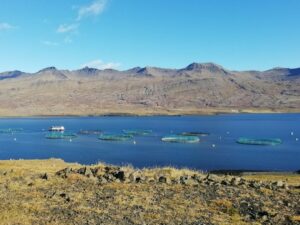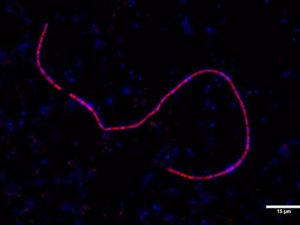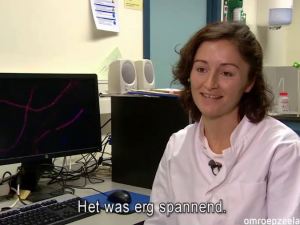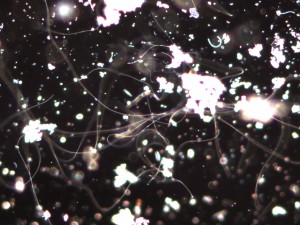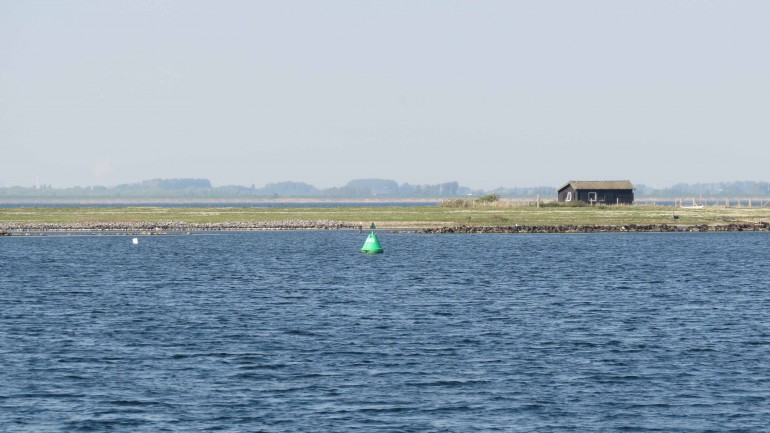
When coastal areas suffer from oxygen depletion, sulfide is released from the seafloor, a chemical compound that is highly toxic for marine life. Luckily, this scenario is not often observed, but it was unclear why. Researchers from the Royal Netherlands Institute of Sea Research, Utrecht University and the Vrije Universiteit Brussel have now discovered that electricity-generating bacteria act as a kind of guardian angels and prevent sulfide from escaping the sediment. This discovery is important in helping designing strategies of how coastal ecosystems can cope with future climate change.
Why are toxic nightmares so rare?
Oceanographers have known for long time that under the right conditions, the bottom waters of coastal areas can turn into a real chemical nightmare. In some places, the oxygen gradually disappears from the bottom waters during summer months, and on top of that, the sediments underneath start accumulating hydrogen sulfide, a chemical that is known for its odor of “rotten eggs”, and which is highly toxic to marine life. The situation becomes disastrous when this hydrogen sulfide gas is released from the sediments, and mixed into the overlying water. Such sulfide eruptions are known from a few places in the world, such as the coast of Namibia, where massive cohorts of lobsters have been observed to flee the sea, crawling onto the beach to avoid the poisonous gas in the water. The ecological and fisheries impact of these sulfide cataclysms can be enormous, but luckily, they are really exceptional explains team leader Prof. dr. ir. Filip Meysman. The problem was that we did’t really understand why these events are so rare. It is good to know that you’re lucky, but it is much better to know why you’re lucky. Our study now demonstrates that there is a natural firewall mechanism in place that delays or even prevents the escape of sulfide from sediments. This way, coastal systems that are susceptible to oxygen depletion are protected from the horrid environmental degradation that comes with sulfide release.
Saved by electricity
The mechanism was discovered in Lake Grevelingen, a coastal basin in the south of the Netherlands, which experiences strong oxygen depletion in the deeper waters every summer. In 2012, we went out on a research ship every month, and made a very detailed study of the chemistry and microbiology of the sediments in Lake Grevelingen explains PhD student Dorina Seitaj, the lead author of the study. What we found was really amazing. In spring, the seafloor was colonized by high densities of long, filamentous electricity-generating bacteria. These so-called cable bacteria were only discovered a few years ago, and are able to send an electrical current along their body over centimeter distances. This electrical metabolism allows them to mobilize large quantities of iron deeper in the seafloor. The dissolved iron then moves upwards and precipitates as an orange iron crust near the sediment surface. In summer, high quantities of sulfide are generated within the sediment, but the sulfide cannot escape the sediment. Fatimah Suluh-Gambari, responsible for the sediment chemistry in the research project, clarifies: The iron crust deposited by the cable bacteria has a high binding capacity for sulfide, and so it acts as a firewall against sulfide, sealing the sediment and preventing the release of sulfide into the overlying water.
Global effect
Over the last 5 years, the research team has organized regular field trips to Lake Grevelingen, demonstrating that the electricity-generating bacteria are always present in spring, and so the firewall mechanism is a yearly recurring phenomenon. This is good news for the local oyster fisheries in Lake Grevelingen, as it reduces the risk of mass mortality due to upwelling of deeper toxic waters. Moreover, members of the same research team have recently demonstrated that cable bacteria are also abundant in many other coastal systems worldwide. Therefore, the firewall mechanism may be widespread in other coastal systems that are suffering oxygen depletion in summer. This is particularly relevant, as the frequency and intensity of coastal oxygen depletion is increasing. This is linked to an increased input of nutrients from land to the coastal zone in combination with warmer seawater resulting from climate change.
This study features in the high-impact scientific journal Proceedings of National Academy of Sciences:
Seitaj, R. Schauer, F. Sulu-Gambari, S. Hidalgo-Martinez, S.Y. Malkin, L.D.W. Burdorf, C.P. Slomp, and F.J.R. Meysman. Cable bacteria generate a firewall against euxinia in seasonally hypoxic basins. Proc. Nat. Acad. Sci. USA. doi: 10.1073/pnas.1510152112

